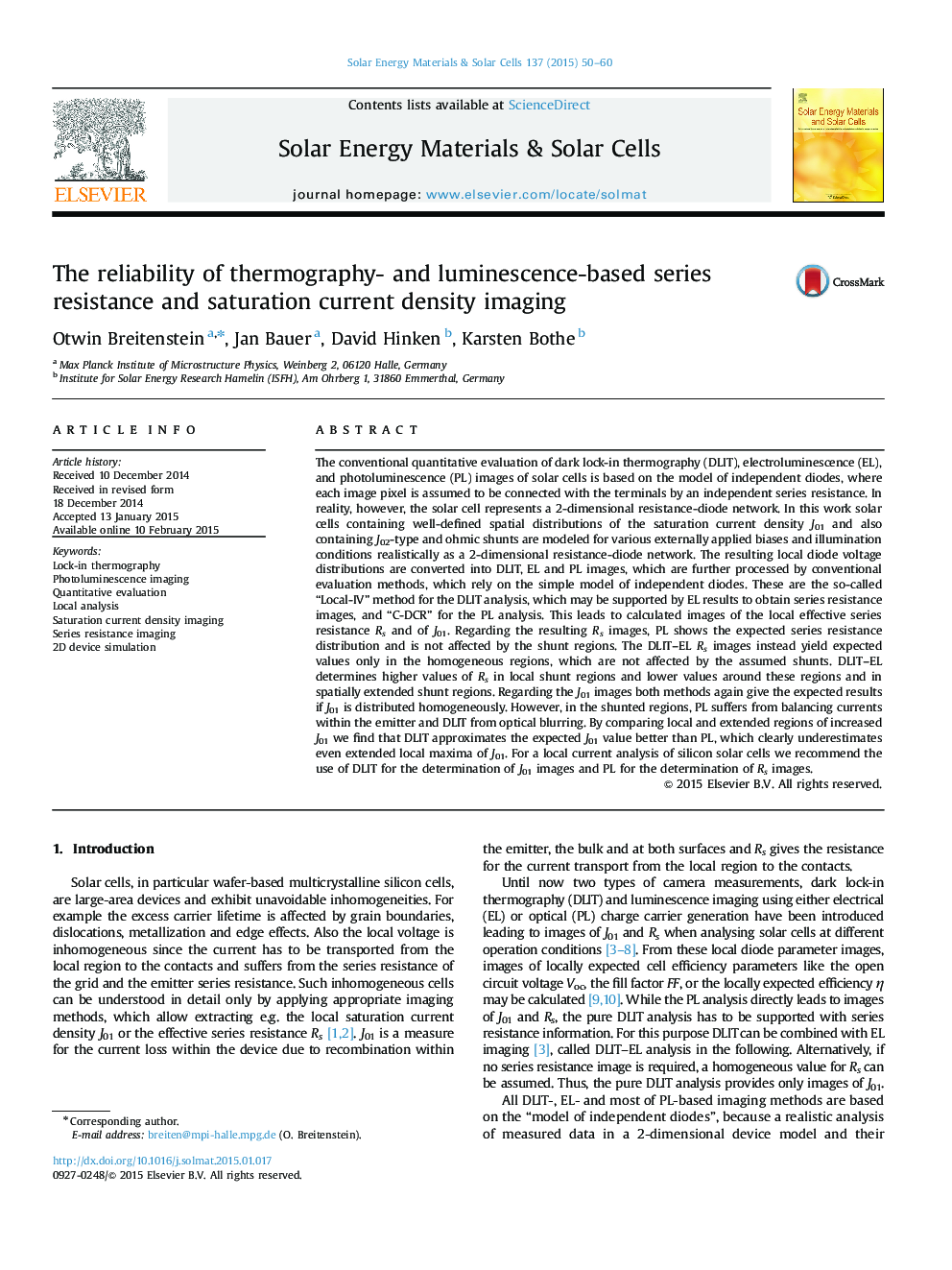| کد مقاله | کد نشریه | سال انتشار | مقاله انگلیسی | نسخه تمام متن |
|---|---|---|---|---|
| 77848 | 49307 | 2015 | 11 صفحه PDF | دانلود رایگان |
• Solar cells with various defects are modelled realistically as a 2D circuit.
• Various illuminated and dark local diode voltages and currents are simulated.
• DLIT and PL images are simulated and evaluated by established methods.
• DLIT- and PL-based effective local Rs and J01 values are obtained for both methods.
• PL–Rs is more realistic than DLIT–Rs, but DLIT–J01 is more realistic than PL–J01.
The conventional quantitative evaluation of dark lock-in thermography (DLIT), electroluminescence (EL), and photoluminescence (PL) images of solar cells is based on the model of independent diodes, where each image pixel is assumed to be connected with the terminals by an independent series resistance. In reality, however, the solar cell represents a 2-dimensional resistance-diode network. In this work solar cells containing well-defined spatial distributions of the saturation current density J01 and also containing J02-type and ohmic shunts are modeled for various externally applied biases and illumination conditions realistically as a 2-dimensional resistance-diode network. The resulting local diode voltage distributions are converted into DLIT, EL and PL images, which are further processed by conventional evaluation methods, which rely on the simple model of independent diodes. These are the so-called “Local-IV” method for the DLIT analysis, which may be supported by EL results to obtain series resistance images, and “C-DCR” for the PL analysis. This leads to calculated images of the local effective series resistance Rs and of J01. Regarding the resulting Rs images, PL shows the expected series resistance distribution and is not affected by the shunt regions. The DLIT–EL Rs images instead yield expected values only in the homogeneous regions, which are not affected by the assumed shunts. DLIT–EL determines higher values of Rs in local shunt regions and lower values around these regions and in spatially extended shunt regions. Regarding the J01 images both methods again give the expected results if J01 is distributed homogeneously. However, in the shunted regions, PL suffers from balancing currents within the emitter and DLIT from optical blurring. By comparing local and extended regions of increased J01 we find that DLIT approximates the expected J01 value better than PL, which clearly underestimates even extended local maxima of J01. For a local current analysis of silicon solar cells we recommend the use of DLIT for the determination of J01 images and PL for the determination of Rs images.
The figure shows the most important results of this work. The cell is one window between two gridlines (top and bottom) and two busbars (left and right) of a standard industrial silicon solar cell. Two geometries are simulated. Geometry A (left) contains one J01-type shunt in the middle, two J02-type shunts left and right from this, and two ohmic shunts at the left and right edges. Geometry B (right) contains three extended regions of increased J01, one in the middle and two left and right. Image (a) is the assumed J01 distribution and (b) is a blurred version of this distribution, since all DLIT results are expected to be thermally blurred. Two kinds of DLIT evaluation were performed, which are the pure DLIT analysis, which assumes a homogeneous Rs distribution, and DLIT-EL, where an EL-based local diode voltage image is used to calculate a more realistic Rs distribution. In all cases a low- and a high-current analysis was performed. We see that the low-current DLIT and DLIT-EL analysis results nicely match the blurred J01 distribution, only the high-current results show certain errors. For PL, which does not suffer from thermal blurring, it was expected that the derived J01 distribution (g) exactly matches the input distribution (a). Unexpectedly, there are large departures; all local maxima of J01 are significantly lower than expected. This paper explains why the PL evaluation reacts much more sensitively to the wrong Rs model of independent diodes used here than the DLIT evaluation. Figure optionsDownload as PowerPoint slide
Journal: Solar Energy Materials and Solar Cells - Volume 137, June 2015, Pages 50–60
